| Grasshopper description | Significant species | Grasshopper control
Grasshoppers are a major pest of both cultivated crops and rangeland grasses in the world's semi-arid regions. Areas receiving less than 750 mm of precipitation in the form of rain or snow are particularly susceptible. Traditionally drier areas like southern Alberta are more prone to recurring problems, but serious grasshopper infestations can occur in cropland throughout the province.
Although the majority of grasshopper damage has been to cereal grains, other crops can be seriously affected. In a more diversified agricultural landscape where cereal crops are often rotated with other cultivars such as canola, lentil and peas, grasshoppers continue to cause significant economic loss in Alberta. Grasshoppers eat 30 to 100 mg of plant material (dry weight) each day.
Forage losses are seldom estimated, but it has been shown that even a moderate infestation of 10 grasshoppers/square metre can typically consume up to 60 per cent of the available forage, depending on the condition of the forage stand. The insects can also consume ALL of the cereal crops, but they usually work the outer edges of fields.
The type and extent of crop damage will depend on the type of crop, how well the crop is growing, the number of grasshoppers present, and whether or not adequate cultural and chemical controls are used.
Grasshopper Description
The name "grasshopper" has been given to a very large and diverse group of insects. All members of the group are characterized by chewing mouth parts, slender bodies, wings that fold lengthwise, large powerful hind legs for jumping and a gradual change in form and size as they develop.
Grasshoppers are divided into two major subgroups: the short-horned grasshoppers (Figure 1) and the long-horned grasshoppers, Mormon crickets and katydids (Figure 2). Short-horned grasshoppers are responsible for most of the reported crop losses. As a result, individuals of this subgroup are popularly referred to as "grasshoppers."
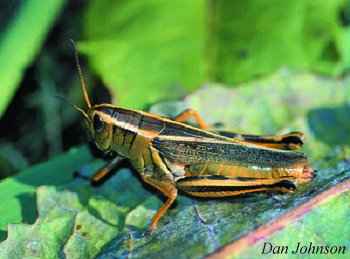 | 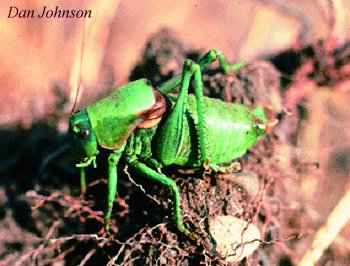 |
Figure 1. A mature two-striped female grasshopper
(Melanoplus bivittatus). Note the distinct two stripes running
he full length of the body and the single black stripe on the
hind leg. | Figure 2. The Mormon cricket (Anabrus simplex) is an example of a long-horned grasshopper. The adult male hangs on vegetation and sings loudly. This species can reach high densities in the U.S., but does not normally cause a problem in Canada. |
North America has more than 600 species of grasshoppers. In Alberta, there are more than 85 species. There are about 12 grasshopper species of economic pest importance at some times, and of these, only four are considered the main pest species.
The species that are considered pests are economically important because under ideal food and weather conditions, these grasshoppers multiply quickly, and when present in large numbers, they feed excessively.
When discussing grasshoppers, it is also important to note that the insects play a significantly positive role in the cycling of nutrients in natural ecosystems since they are food for birds and other animals. In many cases, grasshopper control is not required if they are merely present and are not reaching economic damage thresholds.
Significant Species
The short-horned grasshoppers are divided into three types:
- spur-throated grasshoppers
- band-winged grasshoppers
- slant-faced (also called tooth-legged) grasshoppers
Each type has distinguishing characteristics that make them relatively easy to identify. Producers need to recognize these characteristics if they are to control grasshoppers effectively.
1. Spur-throated grasshoppers (includes pests in the genus Melanoplus)
These grasshoppers are identified by the presence of a tubercle or knob between their front legs (Figure 3). Three of the most economically important species are members of this group: the migratory grasshopper, Packard grasshopper and the two-striped grasshopper.
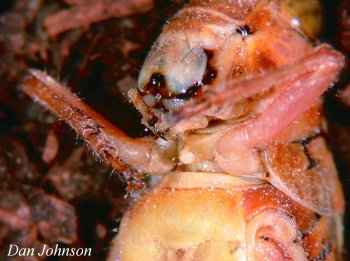 |
| Figure 3. Spur-throated grasshoppers all possess a spur-like structure on their underside, just between where the front legs are attached. |
Migratory grasshopper
The migratory grasshopper (Melanoplus sanguinipes) is a very successful species. It is adapted to every ecoregion of the Canadian grasslands and exhibits remarkable variability in color and physical proportions, such as length of the wings. Of all the species within the genus Melanoplus, M. sanguinipes is the most widely distributed, occurring as far south as Florida.
Distinguishing characteristics - Adult grasshoppers are brownish to yellowish and approximately 23 to 28 mm (0.9 - 1.1 inches) long. Their hind legs are marked with a series of black bands. The newly hatched grasshoppers have black bands on the top of their thorax. In the adult stage, these bands are on the sides of the thorax (Figure 4).
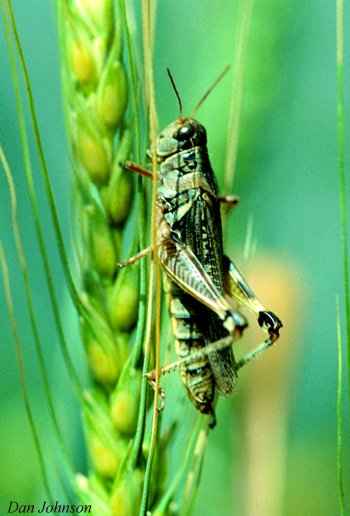 |
| Figure 4. A migratory grasshopper (Melanoplus sanguinipes). This pest grasshopper can be recognized by the dark bands just behind the eyes. |
Habitat - The adult female lays her eggs mainly in stubble fields, but also in drift soil, weedy pastures, brome and alfalfa pastures as well as roadside ditches. Summerfallow fields kept free of weeds are generally free of eggs even though the fields may have a substantial covering of trash.
Food supply - Because the migratory grasshopper is a mixed feeder, it thrives in weedy grain fields, cultivated pastures, hay fields and rangeland. Large numbers may be found in crops adjacent to stubble fields, especially if these fields are summerfallowed in late spring and trap strips have not been used.
Grasshoppers hatching in crops seeded on stubble fields feed on growing seedlings, and damage may go unnoticed until extensive leaf chewing has taken place. Extensive head clipping in cereal crops may occur in late summer when much of the leafy vegetation has been eaten or has matured.
Packard grasshopper
The Packard grasshopper (M. packardii) (Figure 5) typically occurs throughout the prairies, preferring loose sandy soils. There is some colour variability in this species within Alberta, with southern specimens being generally paler.
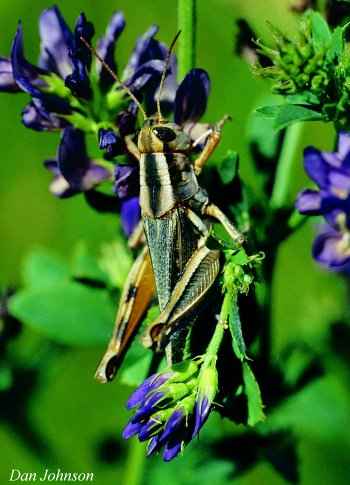 |
| Figure 5. An adult Packard grasshopper (Melanoplus packardii) settling in on an alfalfa plant. Most grasshoppers can eat from 30 to 100 mg of dry weight material per day. |
Distinguishing characteristics - These adult grasshoppers are grey to dark yellow and approximately 27 to
32 mm (1.1 - 1.3 inches) long. Two light-coloured stripes extend from just behind the eyes to the posterior margin of the thorax. The forewings are uniformly grey and lack distinctive stripes. The last two segments of the hind legs are blue-green. When newly hatched, these grasshoppers are pale green to yellow-brown and are speckled with numerous small dark spots (Figure 6).
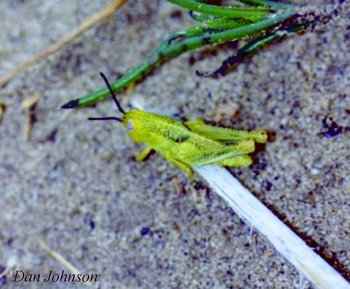 |
| Figure 6. A fourth instar Packard grasshopper (Melanoplus packardii). Note the green wingpads. The young Packard grasshoppers have scattered black dots on their bodies and look much like they walked under a pepper shaker. |
Habitat and food supply - The Packard grasshopper prefers light textured soils with a scanty grass cover and is similar in other respects to the migratory grasshopper.
Two-striped grasshopper
The two-striped grasshopper (M. bivittatus) is widespread throughout Canada and common throughout Alberta.
Distinguishing characteristics - The adult grasshoppers are brownish or greenish with black or brown markings. They are approximately 26 to 40 mm (1.0 - 1.6 inches) in length. They have two pale stripes extending back from the eyes to the tips of the forewings. A solid longitudinal black stripe is evident on the hind legs (Figure 7). Immature grasshoppers are green to yellowish brown.
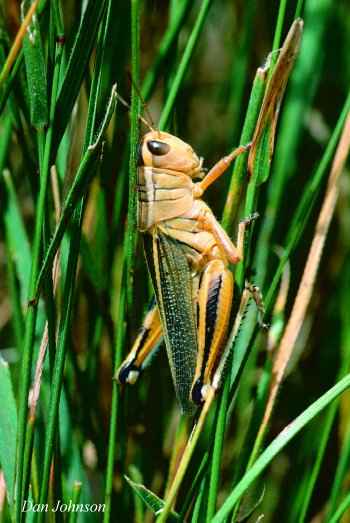 |
| Figure 7. An adult two-striped grasshopper. Note the black stripe on the hind leg as well as the two distinct stripes on top of the body running the full length of the grasshopper. |
Habitat - This species is very common in the heavier- textured soil zones. It is found along roadsides, in dried- out marshes and in fields with crops.
Food supply - The two-striped grasshopper prefers lush foliage such as many of the weed species found associated with marshes and roadside ditches. It is often a pest of alfalfa and other crops. Occasionally, it may feed extensively on some of the trees commonly used as shelterbelts.
2. Band-winged grasshoppers
The main characteristic of band-winged grasshoppers is that the hind wings are usually brightly coloured (Figure 8). While in flight, these grasshoppers may produce a cracking sound with their wings. The Carolina grasshopper with its black wings fringed with a pale border is probably the most noticed member of the group (Figure 9). The most economically important species is the clear-winged grasshopper.
Figure 8(a), (b). The colored wings on these two band-winged grasshoppers are a clear sign that these are not pest species. The clear-winged grasshopper is in the band-winged grasshopper family and is a pest species. However, and as the name implies, the clear-winged grasshopper has clear wings.
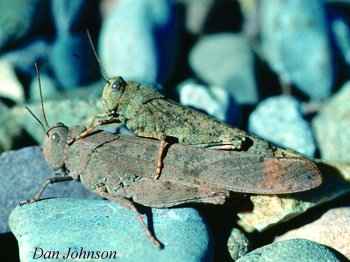 |
| Figure 9. The Carolina grasshopper (Dissosteira carolina) is a band-winged grasshopper. This grasshopper is quite common and is easily recognized by its large black wings with a pale yellow stripe. This grasshopper could become more of a pest concern on the prairies. |
Clear-winged grasshopper
The clear-winged grasshopper (Camnula pellucida) (Figure 10) can be found throughout Alberta; however, this grasshopper exhibits extreme fluctuations in abundance from year to year.
Figure 10. A mature clear-winged grasshopper female.
Distinguishing characteristics - The adults are yellowish to brownish and approximately 21 to 32 mm
(0.8 - 1.3 inches) in length. Their wings are clear but mottled with dark patches, and they have two stripes beginning at the thorax and converging at the tip of the forewings (Figure 11). The newly hatched young are black with a distinctive white band encircling the thorax.
Habitat - The clear-winged grasshopper prefers to lay its eggs in sod on road allowances, overgrazed pastures and dried out marshy areas. Congregation of the adults during egg laying may result in as many as 10,000 or more eggs per square metre.
Food supply - The clear-winged grasshopper is primarily a grass feeder that prefers cereal grains and some of the more succulent cultivated grasses. It seldom feeds on broad-leaved plants. Large pastures of native grasses are usually only infested around their margins where cultivated fields are close by.
3. Slant-faced grasshoppers
This group of grasshoppers is not as abundant as the other types of grasshoppers. This type often goes unnoticed by the casual observer, and these grasshoppers do not generally warrant control measures.
Figure 11. Clear-winged grasshoppers feeding on wheat.
The slant-faced grasshoppers are characterized by a slanting to nearly horizontal face, their clear hind wings, conspicuous sword-shaped or occasionally club-like antennae and broadly rounded thorax. An example of a typical member of this group is shown in Figure 12.
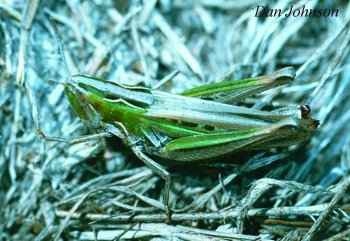 |
| Figure 12. The velvet-striped grasshopper (Eritettix simplex tricarinatus) is a slant-faced grasshopper. Note the spines on the back legs that are used for "singing." |
The slant-faced grasshoppers are usually found along the borders of marshes and in wet meadows. However, some members of this group are also common in dry, grassy fields and pastures. The slant-faced grasshoppers feed primarily on rangeland grasses and sedges. They are seldom associated with cultivated crops. Slant-faced grasshoppers have "teeth" or spines that are used for "singing."
Grasshopper life cycle
The life cycle for all "economically important" grasshoppers in Alberta is essentially the same. During the two weeks following mating, the female grasshopper hunts for an appropriate site to deposit her eggs. Once she selects a site, she bores a hole into the soil with her abdomen and deposits a cluster of cream to orange coloured, slightly bent, cylindrical eggs. She then deposits a foamy secretion over them. This secretion hardens to form an egg pod.
The number of eggs per pod varies greatly, ranging from eight to one hundred and fifty. As a rule, grasshopper species that deposit few eggs per pod produce more pods than those that have many eggs per pod. Under optimum environmental conditions, a single female grasshopper may produce an egg pod every two to four days. Consequently, an average female grasshopper has the capacity, under ideal conditions, to produce more than 250 eggs in her lifetime, although this full potential is rarely achieved in nature.
Embryological development begins once the eggs are laid and continues until environmental conditions become unfavourable in the fall. Development resumes in the spring as the soil temperature rises. A temperature of 10oC is considered to be the minimum temperature at which embryo development will continue.
Hatching of the pest grasshopper species begins between early May and mid-June. Newly hatched grasshoppers, or nymphs, are approximately 5 mm (0.2 of an inch) in length. In appearance, these nymphs resemble adult grasshoppers, except for their size and the absence of wings. After hatching, the young grasshoppers begin feeding almost immediately on the surrounding plants. Although they are preferential feeders if choices are available, the insects cannot travel great distances at this stage and will consume most green vegetation close to the hatching sites.
Nymphal development consists of growth interrupted by periodic skin shedding (moults). When food is abundant and the weather is warm but not too wet, it will take 35 to 50 days for the nymphs to go through the (five occasionally six) nymphal stages before becoming a winged adult. Generally, the adult females are slightly larger than the males.
Annual cycle
Although the life cycle of all grasshopper species is somewhat similar, the annual cycle may vary considerably. Variation between species depends on when the cycle begins and how long it lasts.
Some grasshopper species overwinter as nearly full-grown hoppers and are out the following spring in March and April. All of the pest grasshopper species in Alberta begin their annual cycle in late summer or early fall of the preceding year and overwinter as eggs. These species start to hatch in early May and because of their small size at this time, are easily distinguished from the species that overwinter as larger nymphs.
In Alberta, no grasshopper species has more than one generation per year.
Grasshopper Control
Effects of weather
Temperature, rainfall and snowfall each play a major role in determining the severity of a grasshopper outbreak. Temperature is the most important factor determining the size of the spring grasshopper population. Warm days of the previous spring and summer determine how quickly the parents of the following year's grasshoppers develop and begin to lay eggs. Climatic conditions in the fall are the limiting factors of successful egg laying and thus influence the number of eggs laid. Temperatures will also determine the extent of embryonic development, thereby affecting the time of hatching the following spring.
The effect of cold winter temperatures on grasshopper egg survival is minimal. Experiments conducted at the Lethbridge Research Centre have demonstrated that eggs can survive at -15oC. Soil temperatures in the field rarely fall below -10oC. Any effect on reducing egg survival would require conditions of wind, no snow cover and temperatures of -40oC for a number of days.
Spring temperatures have only a minimal effect on the survival of the grasshoppers that hatch. Young grasshoppers are hardy enough to survive low, even below freezing spring temperatures, providing these temperatures do not persist for several days. The most important aspect of spring temperature is its effect on the grasshopper development and plant growth. If the spring is hot, grasshoppers will hatch early and develop quickly. Cool spring temperatures will slow development. Crop development is also affected by less than ideal temperatures.
The relationship between temperature and rainfall controls the amount of crop damaged by grasshoppers. Under hot, dry conditions, a small grasshopper population may do as much damage as a large grasshopper population will under cool, wet conditions.
Moisture may also influence the size of the grasshopper population. During an extended drought, lack of water may slow the development of many eggs and can destroy eggs, especially during certain embryonic stages and just before hatching (eclosion). However, it has to be extremely dry before the grasshopper embryo begins to die under drought conditions .
Rainfall may affect a localized grasshopper population to a lesser extent. Rainfall will only have an effect if a heavy downpour occurs immediately after an extensive hatch. However, a cool, wet June will not seriously affect grasshopper populations.
The main effect of cool, wet weather is twofold: to reduce crop losses by hindering grasshopper development and to increase the possibility of disease in the grasshopper population, thereby helping to reduce next year's grasshopper population.
Natural enemies
Next to weather, the grasshopper's natural enemies are the most important factor in controlling grasshopper populations. In some localized areas, these enemies may even be a more important factor than the weather. Some of the grasshopper's enemies attack eggs in the soil while others attach to the nymphal and adult stages of the grasshopper.
Egg predators
Among the most important of the egg predators are bee flies, blister beetles, ground beetles (Figure 13), crickets and other insects.
The adults of some of these insects, like the common field cricket, feed directly on the eggs and may destroy up to
50 per cent of the eggs in some areas. Other egg predators like the bee flies and blister beetles, deposit their eggs in the soil near grasshopper eggs.
When the larvae of egg predators hatch, these larvae locate the egg pods and feed directly upon the eggs. When bee flies and blister beetles are abundant, they may destroy up to 80 per cent of the eggs in a localized area.
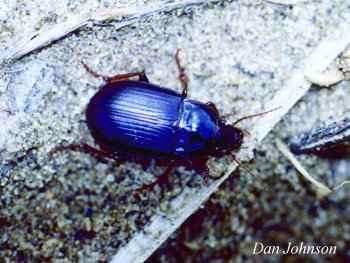 |
| Figure 13. This beetle is a grasshopper egg predator, actively seeking and feeding on grasshopper egg pods. |
Egg parasites
A few other insects, such as the wasp-like members of the genus Scelio, deposit their eggs within the newly-laid grasshopper eggs. The young complete their development within the egg and will emerge, instead of young grasshoppers, in time to parasitize the eggs of the next generation of grasshoppers. These egg parasites may destroy from 5 to 40 per cent of the eggs, as was observed in the 1985 egg survey.
Nymphal and adult predators
Spiders (Figure 14), robber flies (Figure 16), some wasps and many birds may feed on grasshoppers and consume them in large numbers. However, the effect of these predators on the total grasshopper population is not fully known.
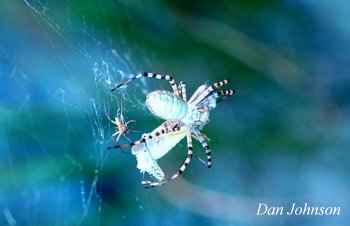 | 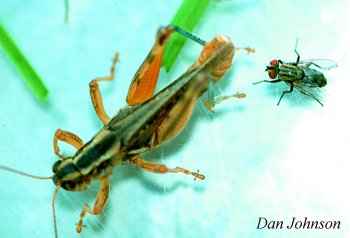 |
| Figure 14. Banded garden spiders preparing to feed on a grasshopper | Figure 15. Grasshoppers have a number of natural enemies. This sarcophagid fly (Blaesoxipha atlanis) is about to deposit a larva directly on this Packard grasshopper (part of an experiment by T. Danyk). The larva will burrow into the grasshopper to feed internally and will leave only when fully developed and ready to pupate. |
Nymphal and adult parasites and diseases
This group contains a large number of natural enemies including flesh flies, robber flies, muscoid flies, tangled vein flies, threadworms, fungi, micro-sporidians and numerous others.
Most of the fly larvae either burrow into the grasshopper when they come into contact with it on the ground, or they are deposited on or into the grasshopper's body. The fly maggot then feeds inside the grasshopper and eventually kills the host as it leaves the body. This group of insects may have a cumulative parasitism of up to 60 per cent.
"Threadworms" are frequently found coiled inside grasshoppers. The "threadworms" overwinter in soil and lay their eggs on the soil or on vegetation. Threadworms attack grasshoppers if the young larvae encounter a grasshopper or if grasshoppers eat threadworm eggs.
The fungus Entomophaga grylii can be effective in controlling grasshoppers under warm, humid conditions. This fungus may occasionally reach epidemic proportions. The disease leaves the corpses of its victims clinging to the stems of plants.
The naturally occurring microsporidian parasite Nosema locustae has also been shown to have an effect on grasshopper populations. A grasshopper becomes infected if it ingests infected vegetation or an already diseased grasshopper.
A grasshopper population infected with this organism may be reduced from 5 to 40 per cent in one year. The parasite can reduce feeding rates to as low as one-third of normal. This parasite also appears to affect grasshopper populations by reducing the number of eggs laid. Attempts to use this organism as a biological control agent have shown only limited success.
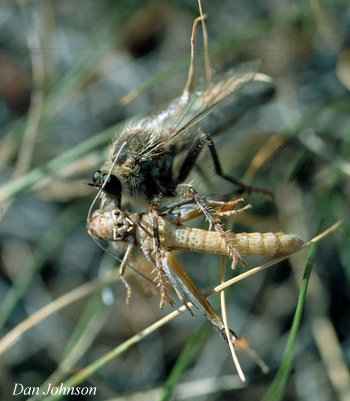 |
| Figure 16. Grasshoppers can also fall prey to robber flies, one of which has just captured this white whiskers grasshopper, Ageneotettix deorum. |
Since most of the natural enemies of grasshoppers are already widespread, it is unlikely that these enemies could be used to prevent grasshopper outbreaks over extensive areas. Such a strategy would only succeed if these natural enemies were cultured and distributed in larger numbers, a very expensive operation.
Nevertheless, natural enemies do play an important role in controlling localized grasshopper infestations, and all are important to some extent in hastening the decline in grasshopper populations.
Cultural control methods
Of all the methods available for grasshopper control, cultural control methods are generally the least expensive. These methods do not require additional or special procedures; they merely involve good management strategies and the proper timing of normal operations necessary in the production of a crop.
By modifying the grasshopper's environment at certain critical periods of its life cycle, a producer may reduce grasshopper numbers directly or can, at least, affect their ability to reproduce.
Despite the advantages cultural control methods offer, many producers are reluctant to use them since it is difficult to assess their effectiveness. Nevertheless, these methods are effective if implemented well in advance of any insect attack. These methods take time to work. Cultural control is a preventive approach to insect control.
The principal cultural methods used to control grasshoppers include:
- early seeding of crops
- crop rotation
- tillage
- trap strips
Early seeding
Crops should be seeded as early as possible. Older plants that are growing vigorously can withstand more grasshopper feeding than younger plants, which are not well established. Although early seeding will not prevent crop damage entirely, it will reduce the amount of damage to crops and will allow more time for the producer to obtain and apply insecticides. Also, early-seeded crops mature early, and migrating grasshoppers are less likely to be attracted to them as they are to lush young foliage.
Crop rotation
Whenever possible, avoid seeding cereals on stubble fields heavily infested with grasshoppers. Cereals should be seeded on stubble fields only where soil moisture is adequate and where one or more applications of an insecticide over the entire field is economical.
Tillage
Cultivation of the soil is a cultural practice available to producers for the reduction of grasshopper populations. Using tillage to control grasshoppers has to be considered carefully, especially under drought conditions. Tillage controls grasshoppers primarily by eliminating the green plants on which grasshoppers feed. The practice is of little value if used for the sole purpose of physically destroying grasshopper eggs or exposing them to desiccation, predation birds and other predators. Excessive tillage is harmful in that it will reduce soil moisture levels and increase the risk of soil erosion.
Fall tillage to get rid of weeds from summerfallow during late summer and early fall will discourage female grasshoppers from depositing their eggs in these fields. Grasshoppers seldom lay eggs in clean summerfallow even when it has a heavy covering of trash. Similarly, thorough field cultivation immediately after harvest will help discourage grasshoppers from laying all their eggs in the field.
It is advisable to complete early spring tillage or chemical fallow to eliminate all green growth on stubble fields before the grasshoppers have hatched. If no food is available for the young grasshoppers to eat when they hatch, they will starve. Early tillage also provides additional benefits: it gives good weed control and conserves moisture at no extra cost.
Tillage can be used as a last resort in fields where there are defined "hot spots," that is, where the young grasshoppers are continuing to hatch in large numbers and continued chemical applications are not desirable. In this situation, the tactic is to bury the eggs and hatching grasshoppers deep enough so that the young hoppers cannot make it to the surface.
Trap strips
If grasshoppers are present when tillage operations begin, it is probably possible to achieve adequate control by simply eliminating all green plant materials in a field. Once grasshoppers have fed and developed to the second stage of growth (second instar) in a field, they are usually mobile enough to move to adjacent crops when their existing food supply is exhausted. In these fields, trap strips should be used to collect grasshoppers into a relatively small area. It will then be possible to control the insects quickly and economically using a minimum amount of insecticide.
To make trap strips, cultivate a black guard strip 10 m wide around the outside of a field. Leave an unworked green strip of at least 10 m before resuming cultivation (Figure 17). Repeat the process as often as necessary to produce additional trap sites.
All green vegetation must be eliminated between the trap strips if they are to be effective. The black guard strip is enough to ensure that grasshoppers will move promptly into the trap strips to feed. However, this trap strip does not have enough vegetation to feed a large grasshopper population for more than one or two days.
Trap strip effectiveness can be improved considerably by seeding the strips to wheat or spring rye several weeks before tillage begins. The migration of young grasshoppers from the cultivated guard strips to the trap strips may take several days.
Once the migration is complete, the trap strips and a 10 m strip of any adjacent crop should be treated with an insecticide. The young grasshoppers are very susceptible to insecticides.The highest application rate recommended for the insecticide used should be applied to ensure adequate control is achieved.
Figure 17. Trap strip around the perimeter of a field.
Credit: Dan Johnson
Before cultivating the trap strips, wait three days to assess the effectiveness of the insecticide. If adequate control is not achieved after three days, it may be necessary to treat the trap strip again. When grasshoppers have been eliminated from the trap strip, it should be possible to complete tillage without fear of displacing large numbers of grasshoppers into the adjacent crops.
Economic thresholds
The economic threshold or density of a pest at which control measures become economically viable has been established in most cereal crops.The economic threshold depends on several factors:
- stage of the insect
- type of crop
- crop stage
- growing conditions
- cost of control
- current market value of the crop
The most serious economic damage due to grasshoppers will be while the insects are in the third to fifth nymphal stages.
Since there are a number of factors to consider, the economic threshold in each situation can vary. Considering the above factors, the economic threshold in cereal crops ranges from 8 to 12 grasshoppers per square metre.
Feeding preference studies have shown that oats is an exception and is not a preferred food source for grasshoppers. If choices are available, the grasshoppers will ignore oats in favour of a more desirable food source. Peas are another example of a non-preferred crop. In both these cases, even if grasshoppers do feed on the crop, damage is more limited, and their biotic or reproductive potential is reduced. Therefore, these crops can be used as a guard strip around more preferred crops.
This strategy is a reverse of the trap strips previously considered. In this case, the grasshoppers will tend to look for other food options rather than penetrate the guard strip into the main crop.
Lentil has been shown to be more susceptible to grasshopper feeding than other crops. Grasshoppers are partial to developing lentil pods above the canopy. The insects will even part the flower parts to consume the early minute pods.
Yield losses result if entire pods are consumed, but even moderate feeding on the pods will break the integrity of the pod, resulting in premature shattering and subsequent yield loss. If the feeding on the pod is less severe but still results in holes in the pod, the risks of disease and staining of the seeds, which will result in a grade loss, are increased. Because of these factors, the economic threshold in lentil is considered to be only two grasshoppers per square metre.
Canola is not a preferred crop for some species of grasshoppers; however, grasshoppers will still feed on the crop. Canola can be damaged when it is very young and again when the pods are ripening, but it is fairly safe in between. However, significant damage can occur at all stages of growth when grasshopper pressure is high.
Early observations suggest that B. napus canola varieties have more trouble recovering from grasshopper feeding than do B. rapa varieties. B. juncea varieties appear to recover best out of the three.
Field experiments conducted at the Lethbridge Research Centre to investigate grasshopper damage just before harvest demonstrated that both the migratory and the two-striped grasshopper caused significant pod and seed damage.
The migratory grasshopper damaged pods primarily by chewing holes in the pods, and the two-striped grasshopper generally removed whole strips from the sides of pods. Both grasshopper species reduced yield enough to justify an insecticide application. The two-striped grasshopper consistently reduced profits in canola more than the migratory grasshopper.
An economic threshold of 7 to 12 grasshoppers per square metre is recommended for canola.
Prepared by:
James Calpas - Provincial Integrated Pest
Management Specialist
Alberta Agriculture, Food and Rural Development
Dan Johnson - Senior Research Scientist
Agriculture and Agri-Food Canada
References
Johnson, D., K. Topinka, and C. Webber. 1991. "Economics of controlling grasshoppers in mature canola." Annual meeting of the Entomological Society of Canada, Saskatoon.
Source: Agdex 622-27. March 2003 |